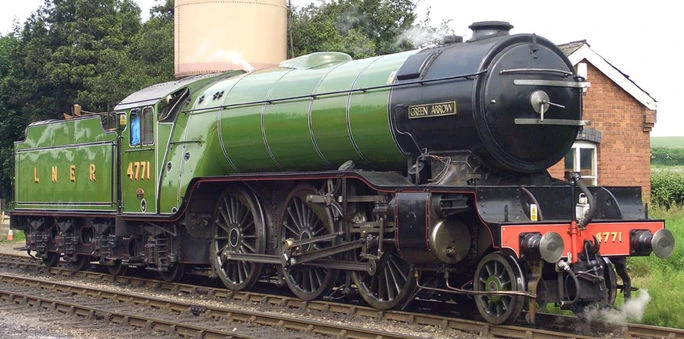The LNER Class V2 4771, known as Green Arrow, stands as a testament to the ingenuity of Sir Nigel Gresley, the renowned Chief Mechanical Engineer of the London and North Eastern Railway (LNER). Built in 1936 at Doncaster Works, Green Arrow was the first of the V2 class locomotives, a series designed for express mixed traffic duties. Notably, it is the only surviving member of its class, making it an invaluable piece of railway heritage.
Design and Development
The V2 class was conceived to address the need for a versatile locomotive capable of handling both passenger and freight services. Gresley, drawing from his experience with the A1 and A3 Pacifics, designed the V2 with a 2-6-2 wheel arrangement. This configuration allowed for a larger firebox, enhancing the locomotive’s power output, while the front pony truck provided stability at high speeds.
Green Arrow’s design incorporated several advanced features:
- Three-cylinder configuration: All three cylinders were cast as a single monobloc, a design choice that was innovative for its time.
- Boiler pressure: The locomotive operated at a boiler pressure of 220 psi.
- Tractive effort: It produced a tractive effort of 33,730 lbf, enabling it to haul heavy loads efficiently.
- Power output: Green Arrow delivered a power output of 2,382 horsepower.
These specifications underscored the locomotive’s capability to perform a range of duties across the LNER network.
Operational History
Upon completion, Green Arrow was allocated the number 637 and fitted with curved nameplates over the middle driving wheels. Before entering service, its number was changed to 4771, and the nameplates were replaced with straight ones mounted on the sides of the smokebox. The name “Green Arrow” was inspired by an LNER express freight service, reflecting the locomotive’s intended role.
Green Arrow’s service was primarily focused on express mixed traffic duties. However, like many of its contemporaries, it faced the challenges of the post-war era, including the decline of steam power and the rise of diesel and electric traction. Despite these challenges, Green Arrow continued to serve until its withdrawal in August 1962.
Preservation and Legacy
Recognizing its historical significance, Green Arrow was preserved as part of the National Collection. It was cosmetically restored at Doncaster Works, with the work completed in April 1963. The locomotive was then moved to various locations, including Hellifield and Wigston, before being transferred to the National Railway Museum (NRM) in York.
In 1972, Green Arrow was returned to working order at Norwich depot. It undertook several special trains, including a notable run in 1979 as part of “The Centenary Express” to celebrate on-train catering. However, by 2008, the locomotive’s boiler had deteriorated, and it was withdrawn from service.
Currently, Green Arrow is on static display at the NRM’s Locomotion site in Shildon. While its boiler is repairable, the cost of restoration has been a limiting factor. Nonetheless, the locomotive remains a symbol of British engineering excellence and a link to the golden age of steam.
Cultural Impact
Beyond its technical achievements, Green Arrow holds a special place in the hearts of railway enthusiasts and the general public. Its distinctive green livery and streamlined design made it one of the most admired locomotives of its time. The name “Green Arrow” itself evokes images of speed and efficiency, aligning with the locomotive’s performance capabilities.
The preservation of Green Arrow ensures that future generations can appreciate the craftsmanship and innovation that went into its design and construction. It serves as an educational resource, offering insights into the technological advancements of the 1930s and the evolution of railway engineering.
Conclusion
LNER Class V2 4771 Green Arrow is more than just a locomotive; it is a piece of living history. From its innovative design by Sir Nigel Gresley to its service on the LNER network and eventual preservation, Green Arrow encapsulates the spirit of an era when steam power was at its zenith. As the last surviving member of the V2 class, it stands as a testament to the ingenuity and dedication of those who built and operated it.
Through its continued presence at the National Railway Museum, Green Arrow ensures that the legacy of British steam locomotives endures, inspiring future generations to appreciate the rich history of railway engineering.

